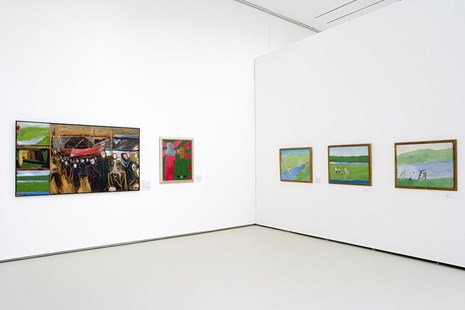Povilas Ričardas Vaitiekūnas

Povilas Ričardas Vaitiekūnas. 'Paintings. Drawings'
Cézanne once said, after looking at some paintings by Monet: "Monet is just an eye, but my God, what an eye!" This quote would not be out of place if it were used to refer to the paintings by Povilas Ričardas Vaitiekūnas.
Although his work could be classed as Expressionist, he is, in fact, a Realist painter. Expressionism manifests itself in his work in the tense colour relationships and in the expressive strokes. The drawing, which is traced in thickly layered paint or lines drawn with the handle of a brush, is prominent as well. But Vaitiekūnas himself has stated that the principal creative impulses, the infection, are reality and nature, and that using fantasy to construct fiction in art is essentially a lie. He compares himself to Rousseau, Corot and Millet, painters of the 19th-century Barbizon school.
His paintings depict the River Nemunas in Vilijampolė before the construction of the hydroelectric power station, or the landscape around Šeštokai, with the railway running through it, or the meadows around the monastery at Pažaislis, or the edges of the woods at Mardasavas … Their Realist agenda also encompasses the artist's life and the milestones in it. The scenery around Vilijampolė, Veršvai and Šeštokai framed his childhood. Kaunas is especially important, as he lived and taught in the city.
Between 1967 and 1976 he worked on his paintings in a ward of the psychoneurological hospital that was based in Pažaislis at the time. Vaitiekūnas spent his summers in the Dzūkija region, in Česukai and later in Mardasavas. His paintings resemble documents recording the past, not only the landscapes, but also the light, the relationship between the colours of the sky and the earth, and tones in water. Looking at these works, we can see the light that surrounded him in his childhood; we can let our eyes rest on the shimmering surface of the Nemunas near Česukai as it looked in 1977; and we can feel what the summer of 1987 was like. The paintings show that certain colour combinations, just like the artist's gaze itself, are part of a particular period or epoch. The earlier ones were dictated to the painter by nature, but painting is also a cognitive process. How Vaitiekūnas paints a meadow! He is a pantheist, because he believes that every creation of nature, and every object, is alive. The silhouettes of fir trees are transformed into human shapes, haystacks turn into the figures of pilgrims, a stone resembles a skull … The symbolic nature of his paintings brings them close to the works of Munch and Čiurlionis. Although these artists belong to different epochs, they are brought together by the theme of death. But in Munch's work, death and the fear of it come from the human being's inner world and anxiety, while Vaitiekūnas transfers to his paintings the primordial terrifying danger inherent in nature and in natural phenomena. The artist created his own individual system of symbols, the figures of the Lady Guest or the Guest at Easter, whose empty hoods turn into scythes that cut through the landscape. The motif of the hood or skull often appears in paintings that depict figures lying in bed as well. Besides these and other borrowings from European culture (embodied by the likes of Pasternak, Tsvetayeva, Baudelaire and Whitman), Vaitiekūnas was inspired by Lithuanian sources: by folklore (the fables written down by Basanavičius, or the writings of Daukantas), by paintings by members of the Ars group, especially by Gudaitis, by avant-garde literature and poetry (Mykolaitis-Putinas, Binkis, Tysliava, and others), by conversations held by the bohemians of Kaunas at the time, and much more. His contemporaries and friends, Martinaitis, Paliokas, Stankevičius, Mikutis and many others, also belong to Vaitiekūnas' times.
This exhibition is a retrospective of work by Povilas Ričardas Vaitiekūnas, from his earliest to his most recent paintings and drawings produced in the village of Mardasavas.
Curator Milda Žvirblytė


